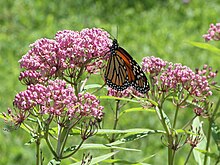| Asclepias | |
|---|---|

| |
| Asclepias incarnata (swamp milkweed) flowers and a monarch butterfly | |
| Scientific classification | |
| Kingdom: | Plantae |
| Clade: | Tracheophytes |
| Clade: | Angiosperms |
| Clade: | Eudicots |
| Clade: | Asterids |
| Order: | Gentianales |
| Family: | Apocynaceae |
| Subfamily: | Asclepiadoideae |
| Tribe: | Asclepiadeae |
| Subtribe: | Asclepiadinae |
| Genus: | Asclepias L.[1] |
| Type species | |
| Asclepias syriaca L.
| |
| Species[2] | |
| Synonyms[3] | |
|
List
| |
Asclepias is a genus of herbaceous, perennial, flowering plants known as milkweeds, named for their latex, a milky substance containing cardiac glycosides termed cardenolides, exuded where cells are damaged.[4][5][6] Most species are toxic to humans and many other species, primarily due to the presence of cardenolides. However, as with many such plants, some species feed upon milkweed leaves or the nectar from their flowers. A noteworthy feeder on milkweeds is the monarch butterfly, which uses and requires certain milkweeds as host plants for their larvae.
The Asclepias genus contains over 200 species distributed broadly across Africa, North America, and South America.[7] It previously belonged to the family Asclepiadaceae, which is now classified as the subfamily Asclepiadoideae of the dogbane family, Apocynaceae.
The genus was formally described by Carl Linnaeus in 1753,[8] who named it after Asclepius, the Greek god of healing.[9]
- ^ "Taxon: Asclepias L." Germplasm Resources Information Network. United States Department of Agriculture. 13 March 2003. Retrieved 5 February 2013.
- ^ "Asclepias". NCBI taxonomy. Bethesda, MD: National Center for Biotechnology Information. Retrieved 10 August 2018.
- ^ "Asclepias L. | Plants of the World Online | Kew Science". Plants of the World Online. Retrieved 12 February 2024.
- ^ Singh, B.; Rastogi, R. P. (1970). "Cardenolides-glycosides and genins". Phytochemistry. 9 (2): 315–331. Bibcode:1970PChem...9..315S. doi:10.1016/s0031-9422(00)85141-9.
- ^ Agrawal, Anurag (7 March 2017). Monarchs and Milkweed: A Migrating Butterfly, a Poisonous Plant, and Their Remarkable Story of Coevolution. Princeton University Press. ISBN 978-1-4008-8476-6.
- ^ Agrawal, Anurag A.; Petschenka, Georg; Bingham, Robin A.; Weber, Marjorie G.; Rasmann, Sergio (1 April 2012). "Toxic cardenolides: chemical ecology and coevolution of specialized plant–herbivore interactions". New Phytologist. 194 (1): 28–45. doi:10.1111/j.1469-8137.2011.04049.x. ISSN 1469-8137. PMID 22292897.
- ^ "Asclepias L." Plants of the World Online. Royal Botanical Gardens, Kew. Retrieved 23 November 2018.
- ^ "Asclepias". ipni.org. International Plant Names Index. Retrieved 23 November 2018.
- ^ Quattrocchi, Umberto (29 November 1999). CRC World Dictionary of Plant Names: Common Names, Scientific Names, Eponyms, Synonyms, and Etymology. CRC Press. p. 211. ISBN 0-8493-2673-7.
Latin asclepias and Greek asklepias for the common swallowwort; Asclepius, Greek god of medicine, the worship of Asclepius was centered in Epidaurus. See W.K.C. Guthrie, The Greeks and Their Gods, 1950; Carl Linnaeus, Species Plantarum. 214. 1753 and Genera Plantarum. Ed. 5. 102. 1754.